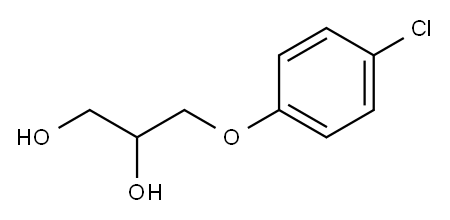Chlorphenesin: applications and toxicology
May 29,2023
General Description
Chlorphenesin is a synthetic glycol compound with the chemical formula C8H11ClO3 and a molecular weight of 202.63 g/mol. It exists in the form of white, crystalline powder and has both medical and cosmetic applications. In medicine, chlorphenesin acts as a
muscle relaxant and is commonly used to treat conditions such as muscle spasms and spasticity. In cosmetics, chlorphenesin is often used as a preservative to prevent bacterial growth and extend the shelf life of skincare and personal care products. It works by interfering with nerve signals between the brain and muscles, leading to a relaxing effect on the affected area. However, it can cause side effects such as skin irritation or allergic reactions, and precautions should be taken during use. Overall, Chlorphenesin has proven to be useful in various medical and cosmetic contexts for its ability to reduce muscle tension and extend product shelf life.

Figure 1. Properties of chlorphenesin
Applications
![]() Muscle relaxant
Muscle relaxant
In pharmaceutic, chlorphenesin has been described as a relaxant for skeletal muscle. Its pharmacological properties have been described by Berger and Bradley. 1 Therefore, even if no cases have been reported, it is important to note that due to its muscle relaxant properties, the U.S. Food and Drug Administration has recommended not to use it in creams that may be in contact with lactating women breasts, in order to avoid any ingestion of this substance by baby. 2
![]()
![]() Cosmetics
Cosmetics
Chlorphenesin reportedly functions as a biocide in cosmetic products.1 Reportedly, chlorphenesin has bactericidal activity against gram-positive and gram-negative bacteria, fungicidal activity against Aspergillus niger IMI 149007, and Penicillium pinophilum IMI 87160 (fungi), and is also active against Candida albicans NCPF 3179 and Saccharomyces cerevisiae NCPF 3275 (yeasts). According to information supplied to the US Food and Drug Administration (FDA) by industry as part of the Voluntary Cosmetic Registration Program (VCRP) in 2011, chlorphenesin is used in 1386 cosmetic products. 3
Toxicology
Oral Toxicity
Chlorphenesin has an acute oral toxicity with a mean lethal dose of 3000 mg/kg. Signs of toxicity observed in rats during a 14-day observation period after receiving single oral doses of the substance included dyspnea, hypotonia, piloerection, and loss of reflex, along with intestinal meteorism and lung congestion in animals that died. In a repeated dose toxicity study on rats, clinical findings in the highest dose group included abnormal gait, pallor, lethargy, ptosis, a badly groomed appearance, noisy respiration, and piloerection. Statistically significant decreases in body weight gain and hemoglobin levels, as well as increases in glutamic pyruvic transaminase were reported for rats in high-dose groups. Kidney damage was also observed in one rat at high dose, and lower spleen and thymus weights were observed in high-dose groups. The no adverse effect level for chlorphenesin in this study was considered to be 10 mg/kg/d. 4
![]() Ocular Irritation
Ocular Irritation
Chlorphenesin was evaluated for ocular irritation potential in New Zealand albino rabbits. Slight conjunctival irritation (enanthema, chemosis, and lacrimation) was reported for each rabbit, indicating that chlorphenesin is a weak ocular irritant. 5
![]()
![]() Skin Irritation and sensitization
Skin Irritation and sensitization
Chlorphenesin was evaluated for skin irritation and sensitization potential using animal models. A range-finding test determined the maximal non-irritant concentration of chlorphenesin, and subsequent testing did not induce irritation at any of the concentrations tested. In a modified guinea pig maximization test, chlorphenesin did not induce sensitization at concentrations of 1% followed by challenge with 0.5% or 1.0%. These results suggest that chlorphenesin has low potential to cause skin irritation or sensitization. 5
Immunosuppression
The potential immunosuppressive activity of chlorphenesin was acknowledged based on in vitro assay results. However, after considering that dosing with chlorphenesin did not increase the susceptibility of animals to infections or act as a tumor promoter in in vivo studies, it was agreed that there would be very little to no safety concern relating to the immunosuppressive activity of chlorphenesin as an ingredient under current conditions of use in cosmetic products. 6
Reference
1. Wakelin SH, White IR. Dermatitis from chlorphenesin in a facial cosmetic. Contact Derm, 1997, 37(3):138–139.
2. Dayan MN. Handbook of Formulating Dermal Applications: A Definitive Practical Guide. Scrivener Publishing LLC. John Wiley; Sons, 2016, 702.
3. Johnson W Jr, Bergfeld WF, Belsito DV, et al. Safety Assessment of Chlorphenesin as Used in Cosmetics. Int J Toxicol, 2014, 33:5S-15S.
4. EviC-CEBA. Acute oral toxicity in the rat of the product CPN Batch P20553 (Chlorphenesin). Study report: T 364/9822. Unpublished submitted by the Personal Care Products Council on 9-6-2011, 1993:1–6.
5. EviC-CEBA. Evaluation of the sensitizing potential of the product CPN - batch P30928 in guinea pig maximization test. Study report: T 285/4619. Unpublished data submitted by the Personal Care Products Council on 9-6-2011. 1994:1–18.
6. Berger FM, Fukui GM, Goldenbaum EG, DeAngelo M, Chandlee GC. The effect of chlorphenesin on the immune response. J Immunol, 1969, 102(4):1024–1031.
- Related articles
- Related Qustion
- Chlorphenesin: Scientific exploration of multipurpose chemicals Sep 5, 2024
This paper aims to introduce basic properties, application fields, preparation methods, safety assessment, and safety precautions of chlorphenesin.
- Functions of Chlorphenesin Oct 11, 2019
Chlorphenesin is used in the formulation of aftershave lotions, bath products, cleansing products, deodorants, hair conditioners, makeup, skin care products, personal cleanliness products, and shampoos.
Platinum-based chemotherapy drugs are a type of chemotherapy that uses platinum compounds to treat cancer.....
May 29,2023APITauroursodeoxycholic acid is a bile acid derived from ursodeoxycholic acid. It is naturally produced in the body through a series of enzymatic reactions in the liver.....
May 29,2023APIChlorphenesin
104-29-0You may like
- Chlorphenesin
-

- $53.00 / 100mg
- 2024-10-31
- CAS:104-29-0
- Min. Order:
- Purity: 99.13%
- Supply Ability: 10g
- Chlorphenesin
-

- $999.00/ kg
- 2024-10-31
- CAS:104-29-0
- Min. Order: 1kg
- Purity: 99%
- Supply Ability: 5000
- Chlorphenesin
-

- $180.00 / 1kg
- 2024-10-31
- CAS:104-29-0
- Min. Order: 1kg
- Purity: 99%
- Supply Ability: 20ton






